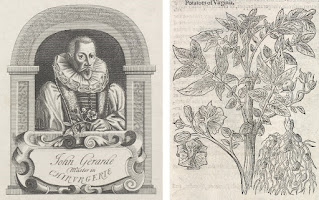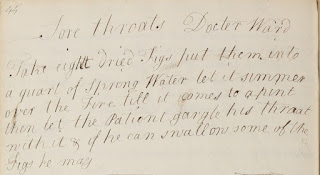1. Potato
John Gerard was a surgeon and plant collector, born in Nantwich in 1545, who compiled a fascinating book that has descriptions of plants, herbs, trees, seaweed, mushrooms, spices and fruit from around the world. His Herbal or General History of Plants is full of beautiful, detailed illustrations. John Gerard was the first to describe the potato of Virginia in English, it was a relative newcomer to our shores when his Herbal was published in 1597. He grew potatoes in his London garden and documented their properties and we also find out how to cook them! They are ‘good and wholesome being either roasted in the embers, or boiled and eaten with oil, vinegar and pepper or dressed some other way by a skilful cook.’
Moving away from potatoes for a moment Gerard also mentions a few local names for plants. He describes ‘worts’ or ‘wortle berries’ (bilberries) ‘prospering upon the hills in Cheshire called Broxen Hills, near Beeston Castle and the people of Cheshire do eat the black wortles in cream and milk’.
You might wonder why remedies are found mingled in with food recipes? It was probably because that at the time the lady of the house would have had some responsibility for the wellbeing of the household as well as planning tasty dishes for supper. The produce from the garden would have provided for both the medicine cabinet and the food larder.
So here it is - a simple concoction – dried figs boiled in water simmered over the fire till reduced and then gargled and if you can swallow some of the figs too that is OK! Figs as we know are packed with vitamins and calcium to boost your immune system so it may have been quite effective. It doesn’t mention side effects of what sounds like syrup of figs!
Moving away from potatoes for a moment Gerard also mentions a few local names for plants. He describes ‘worts’ or ‘wortle berries’ (bilberries) ‘prospering upon the hills in Cheshire called Broxen Hills, near Beeston Castle and the people of Cheshire do eat the black wortles in cream and milk’.
2. Fig
Medical remedies and food recipes go hand in hand back in the 17th century and handwritten recipe books from then contain a mixture of both. You will find cures for all the usual ailments like colds, toothache, spots and gout along with remedies very much of their time - ‘a good drink for the pestilence’ ‘to destroy all poison and plague’ and the rather sinister sounding one ‘to know whether one shall live or die’. Much as we do nowadays remedies and recipes were passed round among friends and neighbours and our fig remedy for sore throats is one that Lady Stanley had picked up from a Doctor Ward.You might wonder why remedies are found mingled in with food recipes? It was probably because that at the time the lady of the house would have had some responsibility for the wellbeing of the household as well as planning tasty dishes for supper. The produce from the garden would have provided for both the medicine cabinet and the food larder.
So here it is - a simple concoction – dried figs boiled in water simmered over the fire till reduced and then gargled and if you can swallow some of the figs too that is OK! Figs as we know are packed with vitamins and calcium to boost your immune system so it may have been quite effective. It doesn’t mention side effects of what sounds like syrup of figs!
3. Orange
We’ll stay in the 17th century for my next flavour. We also have a book of recipes belonging to Eliza Cholmondeley of the Vale Royal Estate in 1677 and in it a very early recipe for orange marmalade. Probably the earliest orange marmalade recipe in English that compares to today’s marmalade. As you look through the recipe books you are struck by the number of different preserves with recipes for ‘marmelet of orrenges’, ‘cherrie marmolet’ and ‘preserving green pippins’.4. Almond
Almonds feature a lot in these two early recipe books with recipes for ‘almonds preserved green’, almond cakes, almond jumbles, almond butter and more. Almonds are still a key ingredient into the next century and in Elizabeth Raffald's Experienced English Housekeeper first published in 1796. She was inspired by her years working at Arley Hall in Cheshire and the publication of her book made her a household name.There are a number of recipes in the book on how to make sweet set puddings flummery and blancmange flavoured with almonds. Blancmange was a savoury set dish until the 1600s. Raffald instructs us how to make ‘clear Blancmange’ with spoonfuls of cream, egg white, calf’s foot jelly to set the pudding and a mixture of sweet and bitter almond paste. Cochineal, saffron and spinach were used to create pink, yellow and green-coloured flummery and this was used to create dishes such as ‘fish pond’ and ‘gilded fish in jelly’! Ceramic moulds were also used to create features to impress and amaze your guests at your 18th century dinner table.
5. Herring
Not a great sounding title to us nowadays but the ‘Radiation Recipe Book’ was supplied with every sale of Regulo gas cookers from the 1930s. It is from our New World/Richmond Gas Stoves collection and was issued with every sale of a Regulo gas cooker. Being able to control cooking temperatures revolutionised the kitchen and liberated women from the stove. During the Second World War the Regulo New World was marketed at women who now had jobs outside of the home. The advert reads ‘Women Who Work: Air Raid wardens appreciate the Super-fast burner’ and follows with claims that it could boil a pint of water in 125 seconds
Home economists of the day created new featured recipes written in a modern style with lists of ingredients and a precise method. And of course they give you an exact gas temperature!
Soused herring, herring baked gently in onions and vinegar and served cold, have always been popular with North Sea coast communities in Scandinavia, Germany, Scotland and the North of England. It appeared as a typical popular recipe in the 1930s - herring were plentiful, provided lots of essential oils and good nutrition at little cost and of course no problem with the Regulo! Time for a revival?






No comments:
Post a Comment